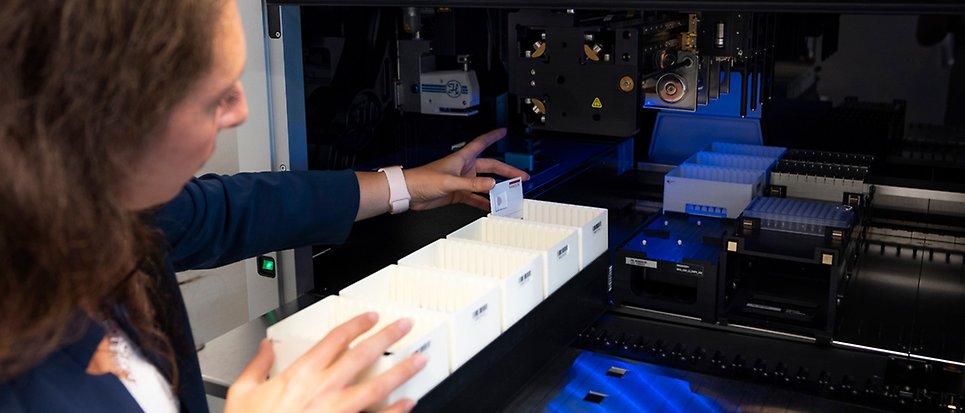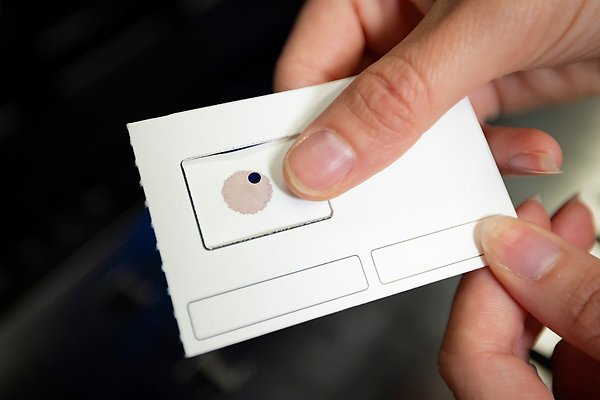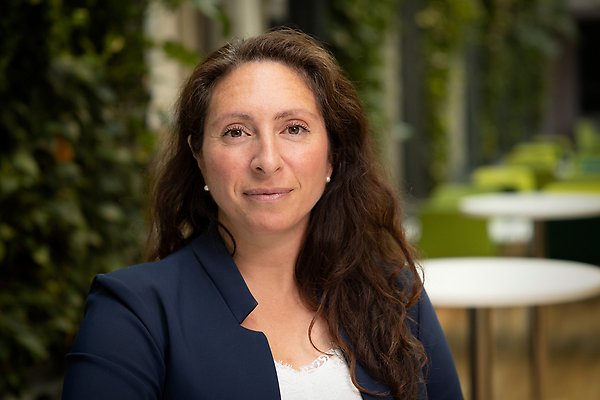Innovative blood sampling card ready to leave the lab

The blood samples collected using these new cards are suitable for a wide range of analyses. Photo: Mikael Wallerstedt
Why is it challenging to detect early signs of diseases, and why does monitoring patient responses to treatment remain a complex task? Researchers from Uppsala University aim to provide new insights and improve lifelong health monitoring, one drop of blood at a time, by rethinking the process of collecting dried blood samples.
Nina Schiller is the CEO and co-founder of the newly established company SampleFacts, leading the development of a novel blood sampling card for dried blood spots. What sets this card apart is its ability to separate blood cells and blood plasma into distinct patient samples at the point of collection. This approach challenges the conventional method of drawing blood samples from the arm, performed by healthcare professionals and later separated through centrifugation in a laboratory setting.
"To unlock the full potential of dried blood spots while matching the current handling of blood samples, the separation of blood is a crucial key," Nina Schiller highlights.

What sets this card apart is its ability to separate blood cells and blood plasma into distinct patient samples at the point of collection. Photo: Mikael Wallerstedt
The blood samples collected using these new cards are suitable for a wide range of analyses. Furthermore, the ability to store dried blood samples at room temperature and their long-term stability simplifies the establishment of biobanks and the monitoring of how patients respond to treatments.
Tool for utilising biomarkers
According to Nina Schiller, this method opens the door wide to the world of biomarkers and, in the long run, a new chapter in our understanding of diseases, their early signs, and progression.
"We eliminate several steps in the sample collection process without losing valuable information about the body's health. This enables us to monitor disease progression and efficiently collect samples from a large number of individuals. Our innovation can offer fresh insights into biomarkers, making it an attractive solution for both researchers and pharmaceutical companies."
Strong team behind the innovation
Behind the project is a dedicated team with experience in biobanking, research, and entrepreneurship in the field of medical technology. The foundation for the sampling card was laid by Professor Ulf Landegren and his former PhD student Johan Björkesten at Uppsala University's Department of Immunology, Genetics, and Pathology. They had previously demonstrated that dried blood samples are suitable for analysis using modern large-scale techniques. Nina Schiller herself was introduced to the project two years ago, having spent some time in Landegren's research group.
"At that time, the card existed only as a conceptual idea, and Ulf asked me to continue developing the patent and the card to make it practically applicable. I didn't hesitate when I recognised the potential of the concept," says Nina Schiller, who has a research background in biochemistry and biophysics from Stockholm University and the Max Planck Institute in Germany.
Addressing a significant research challenge
The first target audience for SampleFacts is researchers who can easily monitor how patients respond to treatment using the sampling card, as Nina Schiller explains.
"Currently, it is both challenging and costly for researchers to access patient samples for their studies. This process demands substantial resources, including medical visits for patients, nurses for sample collection, and proper handling of samples during transport and storage. Our card simplifies sample collection and analysis because patients can collect their own samples and send them by regular mail. Furthermore, sample handling before analysis is automated."

Nina Schiller is the CEO and co-founder of the newly established company SampleFacts. Photo: Mikael Wallerstedt
In addition to making it easier for researchers to study biomarkers in patients at various stages of a disease and under different treatments, Nina Schiller believes that their solution paves the way for creating extensive biobanks with diverse samples, aiding in the early detection of diseases.
From concept to application - progressing toward the market
Over the past two years, the innovation project has made significant progress. Collaborations have been established with researchers and various analysis platforms, and the research community has shown a keen interest in using the sampling card in their studies, as per Nina Schiller.
"We already have ongoing research projects that utilise our card, with more in the pipeline for the autumn. We want to assess how the cards and the entire sample collection and analysis process perform in practice. These projects are pivotal in demonstrating the value of this innovation for research and, ultimately, for the patients themselves."
Sara Gredemark
What is a biomarker?
A biomarker is a measurable indicator, such as a molecule or genetic variant that provides information about a biological process or condition in the body. By analysing biomarkers, one can gain insights into diseases, the effectiveness of treatments, and how the body responds to illness and treatment. Biomarkers play a significant role in medical research and healthcare, as they can increase understanding of disease mechanisms, disease development, and contribute to the development of personalised treatment methods.
